平欧杂种榛是以平榛优系为母本,以欧洲榛品种为父本的杂交种[1],是我国新兴经济林树种。平欧杂种榛的栽培实现了我国榛子产业由野生资源利用向园艺化栽培方式的转变[1]。截至2019 年,全国平欧杂种榛栽培面积达到8.0 万hm2,坚果产量约100万kg[2]。随着平欧杂种榛栽植面积的增加,对平欧杂种榛的施肥研究也逐渐深入。牛兴良[3]通过施肥试验分析表明,随着施肥量增加,平欧杂交榛株高、径粗和叶片光合效率明显提高。王灵哲等[4]通过对平欧杂种榛氮磷钾配施处理得出,适当施肥会增加榛子的光合日累计量和产量;在磷肥适量的情况下,会提高榛树光合效率。许林等[5]对欧榛施用不同类型控释肥分析表明,控释肥能有效改善榛子叶片光合特性,提高生物量。
虽然对平欧杂种榛施肥做了一些研究,但仍停留在以传统土壤施肥为主,榛树的水肥耦合研究还很少。施肥与灌水结合不仅可以提高作物肥水利用率,节水节肥,还可以提高作物产量与品质[6-8]。尤其是近年来,气候因素导致榛树生长期降水不足,严重影响榛树的生长与结实,因此,本试验选取平欧杂种榛生产主栽品种达维,采取不同施肥模式,通过测定叶片光合指标、叶片营养指标、产量和生长量,筛选出最适合平欧杂种榛的施肥模式,以期为平欧杂种榛科学施肥与灌溉提供依据。
1 材料和方法
1.1 试验地概况及供试材料
试验于2019—2021 年在辽宁省锦州市黑山县(E 122°07′7.50″,N 41°40′2.34″)辽宁省经济林研究所榛子试验示范园进行。该地属于温带半湿润区,属中温带大陆性季风气候,年平均气温7.9 ℃,无霜期165 d,年平均降水量为568.4 mm。试验地土壤类型以沙壤土为主,呈中性或弱碱性,土壤有机质含量(w,后同)0.97%,有效氮含量38.36 mg·kg-1,有效磷含量8.95 mg·kg-1,有效钾含量386 mg·kg-1,交换性钙含量7 308.8 mg·kg-1,交换性镁含量709.2 mg·kg-1。供试平欧杂种榛树于2012 年栽植,2016 年挂果,品种为达维,株行距2.0 m×3.5 m。榛园常规田间管理,榛树生长发育正常。
1.2 试验设计
试验主要以追肥方式进行,设置了常规土壤施肥和水肥一体化施肥2种追肥模式。依据2019年8月份所有试验树叶片营养诊断水平及榛树预期产量,确定2020—2021 年度施肥量[9]。依据课题组2018 年度平欧杂种榛不同生育期养分需求规律研究(资料未公开),确定各施肥时期氮磷钾施肥量及比例。除半量施肥模式肥料减半外,其余3 种施肥模式年度总施肥量是一致的。水肥一体化采用盘管式滴头总流量为10 L·h-1·株-1,滴灌处理灌水量相同,施肥量和施肥时期不全相同。水肥一体化模式灌溉施肥时期分别为新梢伸长期、新梢速生期、果仁充实期和采后期。常规土壤施肥时期分别为新梢速生期和果仁充实期。每处理3 次重复,每重复一行树50株。具体施肥处理时期及施肥量见表1。常规土壤施肥(CK)采用条沟施肥,以复合肥(有效氮磷钾含量13%-17%-15%)为基肥,分别以尿素(有效氮含量46%)和硫酸钾(有效钾含量50%)补充氮肥和钾肥不足量,所需肥料混合均匀后一次性施入。水肥一体化施肥(T1和T2)复合水溶肥(有效氮磷钾含量15%-30%-15%)为基肥,分别以尿素(有效氮含量46%)和水溶性硫酸钾(有效钾含量50%)补充氮肥和钾肥不足量,肥料与水质量比1∶9 溶解后,将溶解混合肥料与水以质量比1∶700~800 滴灌施肥,每次施肥一般5~7 d 完成。T3 土壤施肥模式与CK 一致,但在T1 和T2 施肥时期,采用滴灌形式灌水,灌水量与T1 和T2 模式一致。5—7 月是榛树营养生长和生殖生长的关键时期,试验地所在区域月降水量均在150 mm 以下,不能满足榛树生长的需求,需要及时灌水。因此,榛树生育期中5—8月,如果20 cm 深土壤水分含量低于20%,需要滴灌灌水,每天滴灌2 次,每次灌水20 升·株-1,直至土壤湿度高于20%为止。试验地采用太阳能温湿度测定仪记录20、40和60 cm深度的土壤温度和湿度。
表1 榛树水肥一体化施肥处理模式
Table 1 The treatments of water and fertilizer application on hybrid hazelut trees
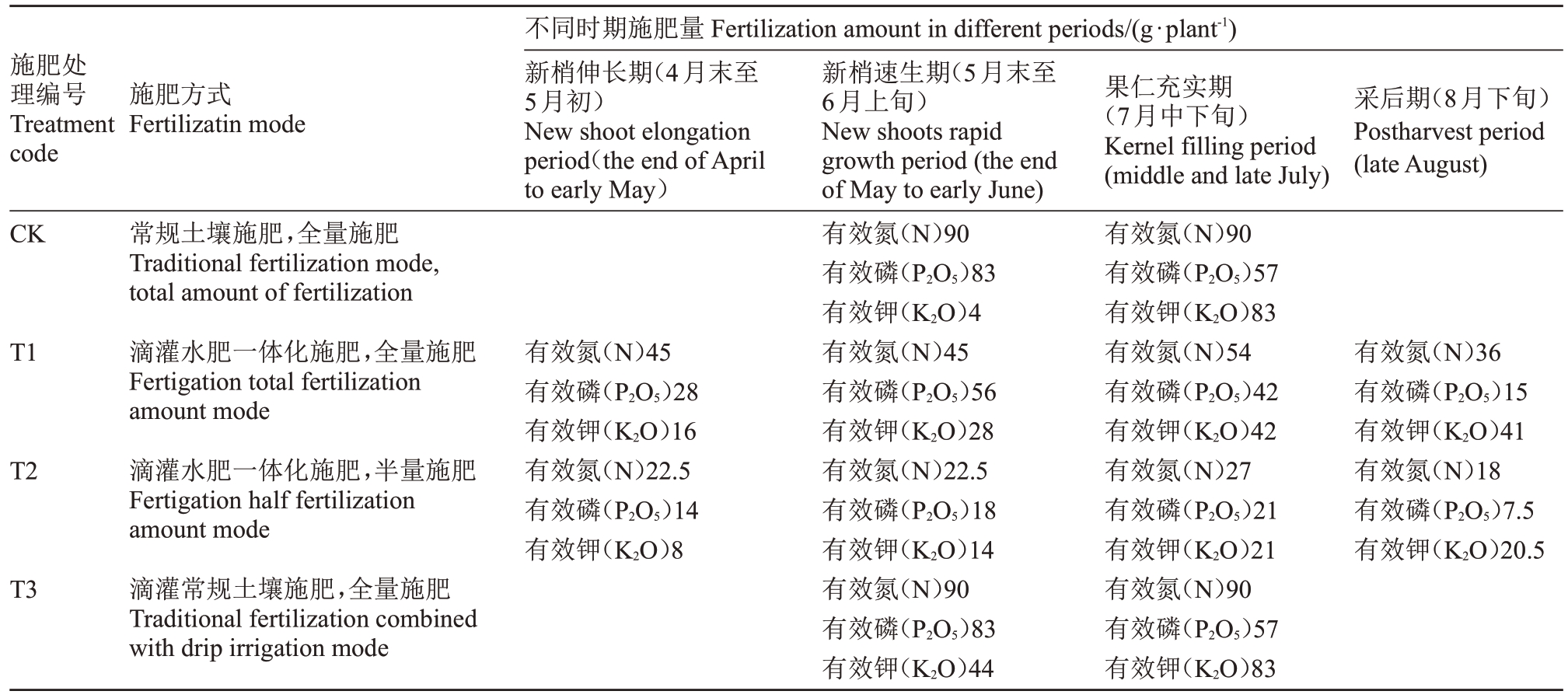
施肥处理编号Treatment code施肥方式Fertilizatin mode不同时期施肥量Fertilization amount in different periods/(g·plant-1)新梢伸长期(4月末至5月初)New shoot elongation period(the end of April to early May)采后期(8月下旬)Postharvest period(late August)CK 常规土壤施肥,全量施肥Traditional fertilization mode,total amount of fertilization T1滴灌水肥一体化施肥,全量施肥Fertigation total fertilization amount mode T2滴灌水肥一体化施肥,半量施肥Fertigation half fertilization amount mode有效氮(N)45有效磷(P2O5)28有效钾(K2O)16有效氮(N)22.5有效磷(P2O5)14有效钾(K2O)8有效氮(N)36有效磷(P2O5)15有效钾(K2O)41有效氮(N)18有效磷(P2O5)7.5有效钾(K2O)20.5 T3滴灌常规土壤施肥,全量施肥Traditional fertilization combined with drip irrigation mode新梢速生期(5月末至6月上旬)New shoots rapid growth period(the end of May to early June)有效氮(N)90有效磷(P2O5)83有效钾(K2O)4有效氮(N)45有效磷(P2O5)56有效钾(K2O)28有效氮(N)22.5有效磷(P2O5)18有效钾(K2O)14有效氮(N)90有效磷(P2O5)83有效钾(K2O)44果仁充实期(7月中下旬)Kernel filling period(middle and late July)有效氮(N)90有效磷(P2O5)57有效钾(K2O)83有效氮(N)54有效磷(P2O5)42有效钾(K2O)42有效氮(N)27有效磷(P2O5)21有效钾(K2O)21有效氮(N)90有效磷(P2O5)57有效钾(K2O)83
1.3 测定指标与方法
1.3.1 光合指标 2020 年7 月17 日,晴朗无云,分别于10:00—12:00、15:00—16:00,每行随机选取5株树,每株树按照东、南、西、北四个方位,选择树体中部外围延长枝中段完全伸展开、完整、无病虫害叶片1 枚,用LI-6400 型便携式光合仪(北京力高泰科技有限公司)测定叶片净光合速率(net photosynthetic rate,Pn)、气孔导度(stomatal conductance,Gs)、蒸腾速率(transpiration rate, Tr)和胞间CO2 浓度(intercelluar CO2concentration,Ci)。
1.3.2 叶片营养指标[9] 8月上旬,每行随机选取5~6 株树,每株树按照东、南、西、北四个方位,选择树体中部外围延长枝中段完全伸展开、完整、无病虫害叶片2片,每行采样树形成一个混合样本用于测定叶片主要营养元素含量。叶片采用蒸馏水清洗3 遍,在85 ℃下杀青1 h,在65 ℃下烘干至恒质量。烘干叶样粉碎后,以硫酸-过氧化氢法消解,半微量凯氏定氮法测氮(N)含量,钒钼黄比色法测磷(P)含量,原子吸收光谱法测定钾(K)、钙(Ca)、镁(Mg)含量。
1.3.3 产量指标[1] 8月中下旬,每行随机选取8~10株树,采集树上果实并做好标记,用于测定单株鲜果质量;将鲜果装于网袋阴干,10 月份测定风干果质量。每株树选择500~600 g 鲜果或者风干果,测定果实粒数,计算平均单果鲜质量或者单果干质量。每株树选择风干果实15~20 粒,采用游标卡尺测定纵横径。纵径为果底至果顶最尖端距离;横径为果实脐线上果实横向最宽距离。
1.3.4 榛树生长量 每年11月下旬,每行随机选取10株树,采用卷尺测定树冠东西和南北树冠直径和树干干周长度(树干距离地面10 cm处)。在树冠东西南北四个方向调查8~10 个一年生延长枝长度与枝条基径。一年生延长枝条长度用卷尺测定,从枝条当年萌发部位至枝条顶端测量;枝条基径使用游标卡尺进行测量,测量部位始终为枝条基部(当年萌生部位)。
冠径=(东西树冠直径+南北树冠直径)/2,
冠径差=下一年度冠径—上一年度冠径,
干周差=下一年度干周—上一年度干周,
延长枝基径/枝长=延长枝基径/延长枝长度值×100。
1.3.5 化肥偏生产力[10](PFP)化肥偏生产力计算公式为:PFP/(kg·kg-1)=施肥后作物产量/化肥纯养分投入量。
1.4 数据分析
采用WPS 2010 进行数据统计,并用SPSS 16.0数据处理软件进行数据显著性分析、Duncon多重比较,最后利用主成分分析对各施肥处理进行综合评价[11-12]。
2 结果与分析
2.1 不同施肥处理对榛树叶片光合指标的影响
对不同施肥处理的试验树叶片的光合作用指标进行了测定分析(表2),结果表明,T1、T2 处理试验树Pn、Gs和Tr均极显著(p<0.01,下同)高于T3 处理和CK,T3 处理试验树Pn、Gs显著(p<0.05,下同)高于CK,但Tr和Ci与CK无显著差异。T1处理试验树Ci极显著高于CK、显著高于T3处理;T2处理Ci显著高于CK,T1、T2和T3处理之间Ci差异不显著。
表2 不同施肥处理试验树叶片光合作用指标比较
Table 2 Comparison of photosynthetic indexes in leaves of different fertilizer treatment

注:不同小写字母表示在p<0.05 差异显著,不同大写字母表示在p<0.01 差异极显著。下同。
Note:Different small letters indicate significant difference at p<0.05,different capital letters indicate extremely significant difference at p<0.01.The same below.
施肥处理Fertilizer treatment T1 T2 T3对照CK Tr/(mmol·m-2·s-1)3.03±0.68 Aa 2.97±0.52 Aa 2.12±0.58 Bb 1.91±0.68 Bb Pn/(μmol·m-2·s-1)12.53±1.38 Aa 12.00±1.01 Aa 9.70±1.50 Bb 8.64±1.50 Bc Gs/(μmol·m-2·s-1)0.12±0.03 Aa 0.11±0.02 Aa 0.08±0.02 Bb 0.06±0.02 Bc Ci/(μmol·mol-1)223.44±21.02 Aa 196.74±25.11 ABab 173.82±54.45 ABbc 157.22±61.87 Bc
2.2 不同施肥处理对榛树叶片主要营养元素含量的影响
对不同施肥处理的试验树叶片的主要营养元素含量进行了测定分析(表3),结果表明,叶片氮含量各施肥处理间差异显著,T1>T2>T3>CK;叶片磷含量T2 处理显著高于其他处理,T1、T3 和CK 处理间差异不显著;叶片钾含量T1 和T2 处理显著高于T3和CK,T1 与T2 间差异不显著;叶片钙含量T1、T2和CK间差异不显著,但与T3处理间差异显著;叶片镁含量各施肥处理间没有显著差异。
表3 不同施肥处理试验树叶片营养含量比较
Table 3 Comparison of leaves nutrient content of different fertilizer treatment

施肥处理Fertilizer treatment对照CK T1 T2 T3 w(平均氮)Average N/%1.99±0.11 d 2.28±0.10 a 2.18±0.11 b 2.07±0.10 c w(平均磷)Average P/%0.10±0.01 b 0.12±0.01 b 0.14±0.01 a 0.11±0.01 b w(平均钾)Average K/%0.39±0.01 b 0.47±0.01 a 0.49±0.02 a 0.41±0.01 b w(平均钙)Average Ca/%3.43±0.16 a 3.49±0.08 a 3.53±0.22 a 3.17±0.43 b w(平均镁)Average Mg/%0.37±0.01 a 0.36±0.01 a 0.38±0.01 a 0.37±0.01 a
2.3 不同施肥处理对榛树产量及果实指标的影响
统计分析不同施肥处理对试验树单株产量及肥料效率的影响,结果(表4)表明,T1、T2、T3 处理试验树的平均单株产量极显著高于CK,T1和T2处理试验树平均单株产量要显著高于土壤施肥结合灌溉处理试验树。T1 与T2 处理间,试验树平均单株产量没有显著差异。T1、T2、T3 处理PFP 均比CK 高,说明水肥处理可以提高肥料利用率。T2 处理PFP最高,比CK 增加了372.3%;T1、T3 处理PFP 分别比CK增加了143.5%和98.2%。
表4 不同施肥处理平均单株产量比较
Table 4 Comparison of average yield per plant of different fertilizer treatment
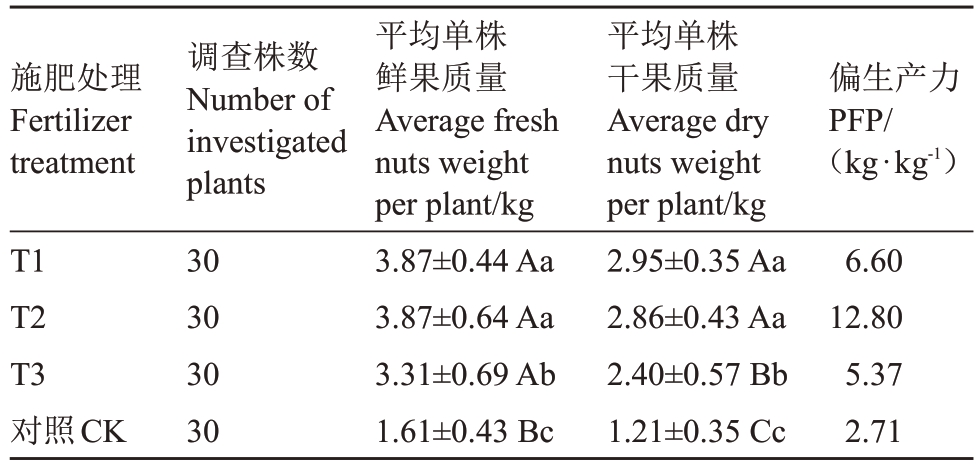
施肥处理Fertilizer treatment偏生产力PFP/(kg·kg-1)T1 T2 T3对照CK调查株数Number of investigated plants 30 30 30 30平均单株鲜果质量Average fresh nuts weight per plant/kg 3.87±0.44 Aa 3.87±0.64 Aa 3.31±0.69 Ab 1.61±0.43 Bc平均单株干果质量Average dry nuts weight per plant/kg 2.95±0.35 Aa 2.86±0.43 Aa 2.40±0.57 Bb 1.21±0.35 Cc 6.60 12.80 5.37 2.71
对不同施肥处理的试验树平均单果质量及果实纵横经进行了测定分析,结果(表5)表明,T3处理试验树平均单果鲜质量与平均单果干质量均极显著高于CK,但与T2、T3 处理间无显著差异,T2、T3 处理间平均单果鲜质量与平均单果干质量均与CK相比无显著差异。尽管T1 和T2 处理果实大小与T3 处理间无显著差异,但是T1、T2 处理试验树果实大小比较均匀,肉眼可见榛果明显比T3、CK 处理的要大。T1、T2、T3 试验树果实横径极显著大于CK,但T1、T2、T3 处理间没有显著差异。T1、T2 处理试验树果实纵径极显著大于CK,但与T3 处理间没有显著差异。T3处理试验树果实纵径与CK间没有显著差异。与CK相比,T1、T2处理可以显著提高果实纵横径。
表5 不同施肥处理试验树平均单果质量及果实纵横径比较
Table 5 Comparison of average nut weight,nut cross or longitudinal diameter of different fertilizer treatment

施肥处理Fertilizer treatment T1 T2 T3对照CK平均单果鲜质量Average fresh nut weight/g 3.77±0.19 Aa 3.65±0.20 ABab 3.59±0.17 ABab 3.50±0.27 Bb平均单果干质量Average dry nut weight/g 2.82±0.14 Aa 2.71±0.16 ABab 2.66±0.18 ABab 2.62±0.21 Bb果实横径Cross diameter of nut/mm 1.93±0.10 Aa 1.91±0.13 Aa 1.91±0.10 Aa 1.87±0.12 Bb果实纵径Longitudinal diameter of nut/mm 2.28±0.10 Aa 2.28±0.11 Aa 2.25±0.11 ABab 2.24±0.13 Bb
2.4 不同施肥处理对榛树生长量的影响
为确定不同施肥处理对试验树生长量的影响,对试验树干周、一年生延长枝长度与基径等指标进行了测定分析,结果(表6、表7)表明,不同施肥处理间试验树冠径增长量(冠径差)与干周增长量(干周差)之间没有显著差异,但T3 处理试验树的一年生延长枝基径与枝长比值显著高于T2、T3和CK,说明在一年生延长枝长度相同的情况下,T3处理试验树的枝条比较粗壮。
表6 不同施肥处理试验树生长量指标比较
Table 6 Comparison of tree growth Indexes of different fertilizer treatment
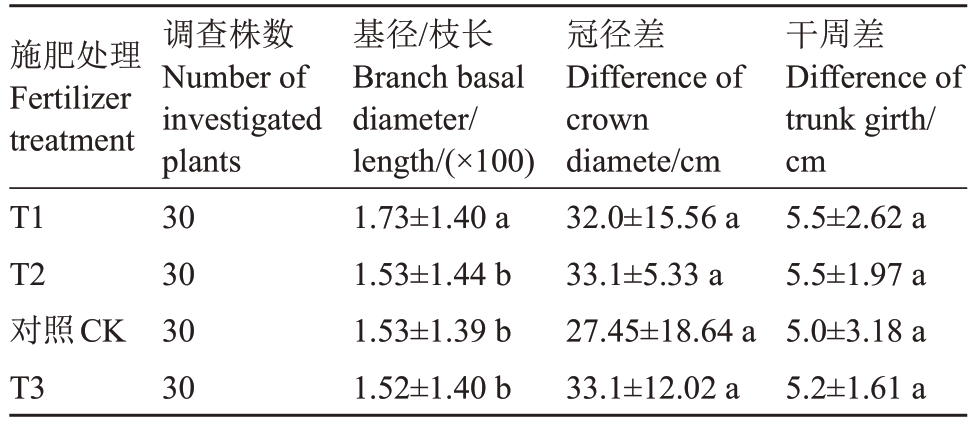
施肥处理Fertilizer treatment T1 T2对照CK T3调查株数Number of investigated plants 30 30 30 30基径/枝长Branch basal diameter/length/(×100)1.73±1.40 a 1.53±1.44 b 1.53±1.39 b 1.52±1.40 b冠径差Difference of crown diamete/cm 32.0±15.56 a 33.1±5.33 a 27.45±18.64 a 33.1±12.02 a干周差Difference of trunk girth/cm 5.5±2.62 a 5.5±1.97 a 5.0±3.18 a 5.2±1.61 a
表7 不同施肥处理试验树一年生延长枝指标比较
Table 7 Comparison of trees branch top tip of different fertilizer treatment
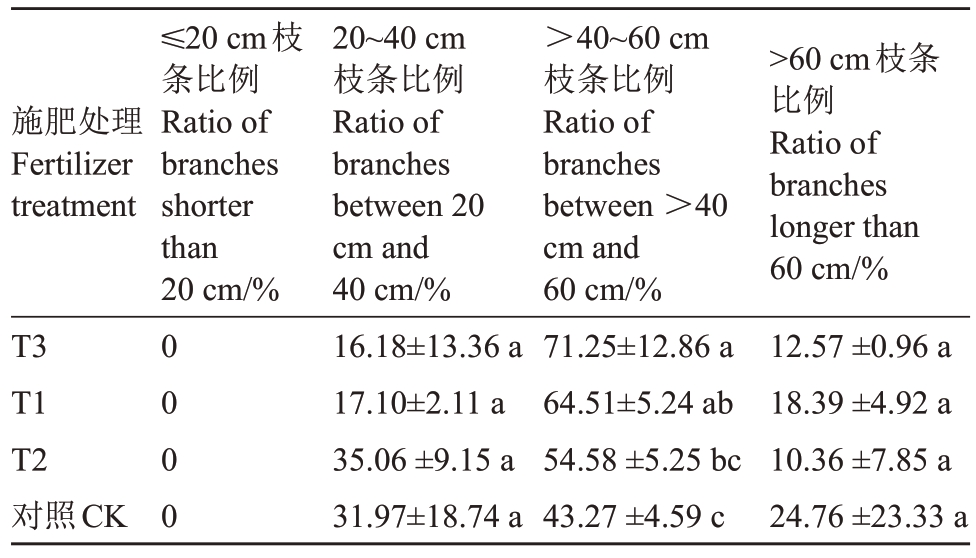
施肥处理Fertilizer treatment≤20 cm枝条比例Ratio of branches shorter than 20 cm/%T3 T1 T2对照CK 0000 20~40 cm枝条比例Ratio of branches between 20 cm and 40 cm/%16.18±13.36 a 17.10±2.11 a 35.06±9.15 a 31.97±18.74 a>40~60 cm枝条比例Ratio of branches between >40 cm and 60 cm/%71.25±12.86 a 64.51±5.24 ab 54.58±5.25 bc 43.27±4.59 c>60 cm枝条比例Ratio of branches longer than 60 cm/%12.57±0.96 a 18.39±4.92 a 10.36±7.85 a 24.76±23.33 a
对不同施肥处理试验树的一年生延长枝长度进行分类比较可见,T1、T2、T3 处理40~60 cm 长一年生延长枝所占比例中明显高于CK,说明T1、T2、T3处理优良结果枝所占比例明显高于CK。尽管T3处理优良结果枝比例比T1、T2处理高,但这可能是T3处理试验树当年产量要明显低于T1、T2 处理,导致树体营养分流到营养生长较多。
2.5 不同施肥处理对平欧杂种榛生长、光合及产量影响的主成分分析
对不同施肥处理的光合指标、叶片主要营养元素含量、产量、果实指标及生长量指标等进行主成分分析。由特征值和各指标贡献率(表8),提取3个主要成分,再由主成分载荷矩阵(表9)获得表达式如下:
表8 主成分的特征值、贡献率和累积贡献率
Table 8 Eigenvalues,variance contribution rates and cumulative contribution rates of principal components
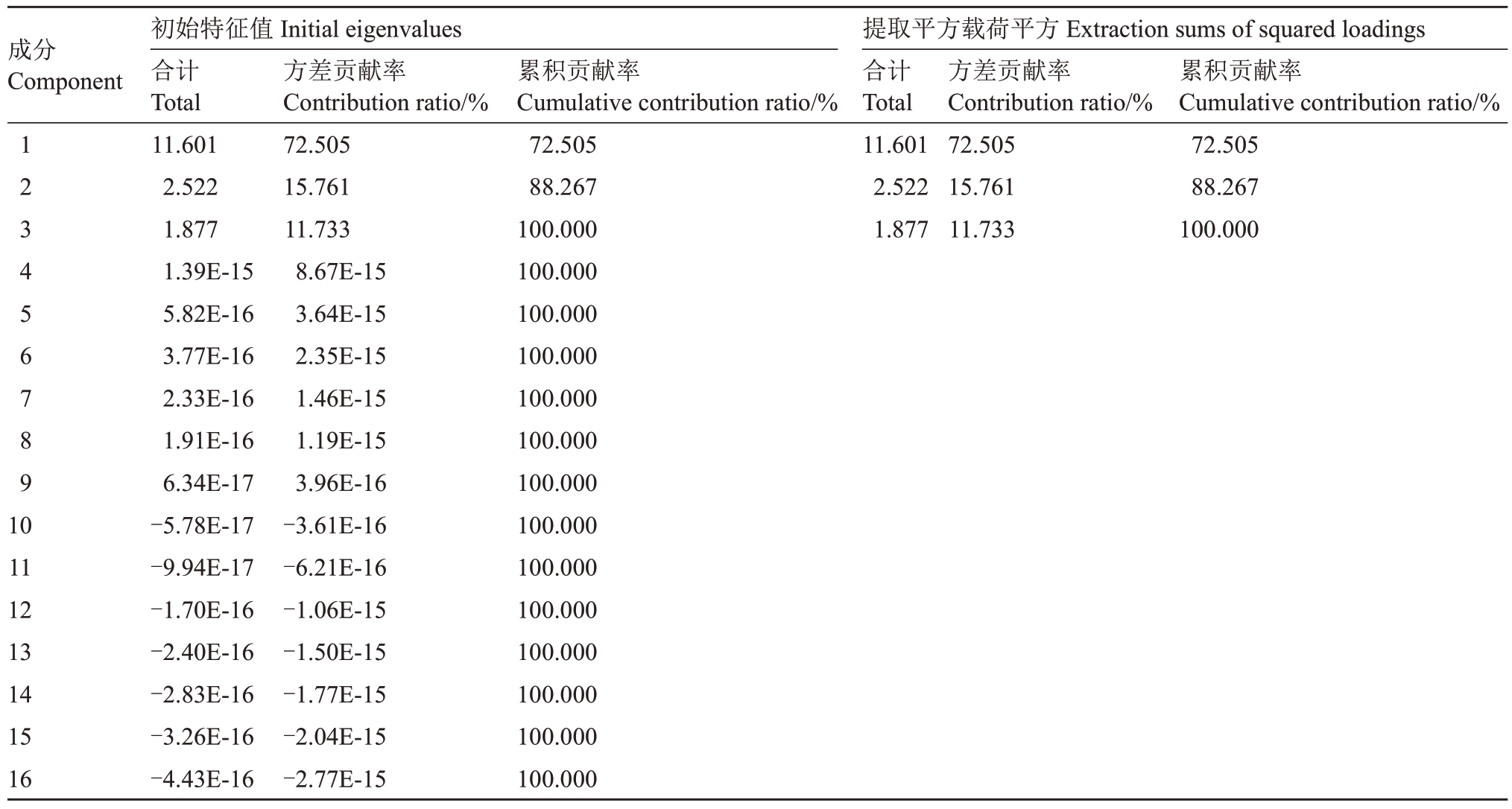
成分Component 123456789提取平方载荷平方Extraction sums of squared loadings合计Total 11.601 2.522 1.877方差贡献率Contribution ratio/%72.505 15.761 11.733累积贡献率Cumulative contribution ratio/%72.505 88.267 100.000 10 11 12 13 14 15 16初始特征值Initial eigenvalues合计Total 11.601 2.522 1.877 1.39E-15 5.82E-16 3.77E-16 2.33E-16 1.91E-16 6.34E-17-5.78E-17-9.94E-17-1.70E-16-2.40E-16-2.83E-16-3.26E-16-4.43E-16方差贡献率Contribution ratio/%72.505 15.761 11.733 8.67E-15 3.64E-15 2.35E-15 1.46E-15 1.19E-15 3.96E-16-3.61E-16-6.21E-16-1.06E-15-1.50E-15-1.77E-15-2.04E-15-2.77E-15累积贡献率Cumulative contribution ratio/%72.505 88.267 100.000 100.000 100.000 100.000 100.000 100.000 100.000 100.000 100.000 100.000 100.000 100.000 100.000 100.000
表9 主成分载荷矩阵
Table 9 Component score coefficient matrix
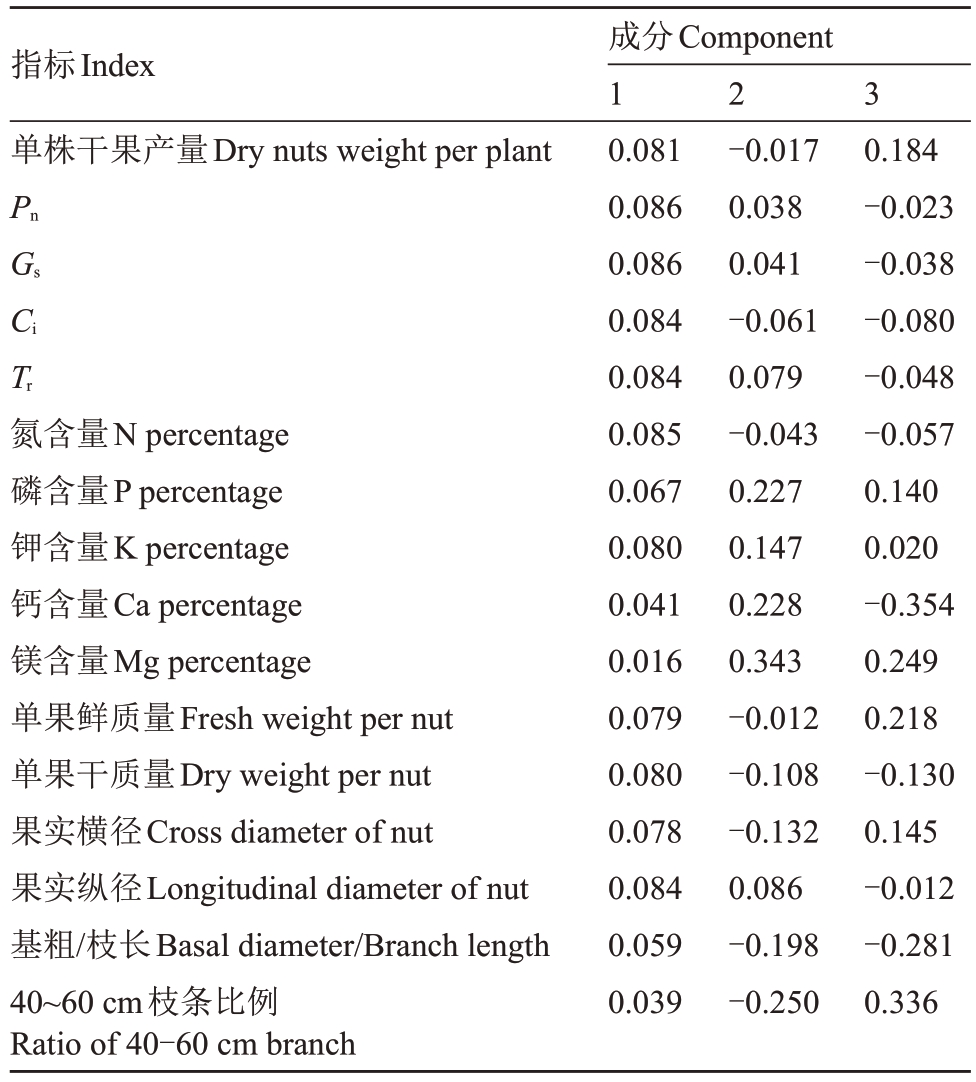
指标Index单株干果产量Dry nuts weight per plant 2 3 Pn Gs Ci Tr氮含量N percentage磷含量P percentage钾含量K percentage钙含量Ca percentage镁含量Mg percentage单果鲜质量Fresh weight per nut单果干质量Dry weight per nut果实横径Cross diameter of nut果实纵径Longitudinal diameter of nut基粗/枝长Basal diameter/Branch length 40~60 cm枝条比例Ratio of 40-60 cm branch成分Component 1 0.081 0.086 0.086 0.084 0.084 0.085 0.067 0.080 0.041 0.016 0.079 0.080 0.078 0.084 0.059 0.039-0.017 0.038 0.041-0.061 0.079-0.043 0.227 0.147 0.228 0.343-0.012-0.108-0.132 0.086-0.198-0.250 0.184-0.023-0.038-0.080-0.048-0.057 0.140 0.020-0.354 0.249 0.218-0.130 0.145-0.012-0.281 0.336
F1=0.081x1+0.086x2+0.086x3+0.084x4+0.084x5+0.085x6+0.067x7+0.08x8+0.041x9+0.016x10+0.079x11+0.08x12+0.078x13+0.084x14+0.059x15+0.039x16(x1:单株干果产量,x2:Pn,x3:Gs,x4:Ci,x5:Tr,x6:叶片氮含量,x7:叶片磷含量,x8:叶片钾含量,x9:叶片钙含量,x10:叶片镁含量,x11:单果鲜质量,x12:单果干质量,x13:果实横径,x14:果实纵径,x15:基粗/枝长(×100),x16:40~60 cm枝条比例,下同);
F2=-0.017x1+0.038x2+0.041x3-0.061x4+0.079x5-0.043x6+0.227x7+0.147x8+0.228x9+0.343x10-0.012x11-0.108x12-0.132x13+0.086x14-0.198x15-0.25x16;
F3=0.184x1- 0.023x2- 0.038x3- 0.08x4- 0.048x5-0.057x6+0.14x7+0.02x8-0.354x9+0.249x10+0.218x11-0.13x12+0.145x13-0.012x14-0.281x15+0.336x16。
对数据标准化后,依据主成分表达式,经计算获得各施肥处理的F1、F2、F3 值及综合主成分值(F)并进行排名[13]。从表10 可见,不同施肥处理综合评价由高到低排名依次为T2>T1>T3>CK,说明T2 处理在所有施肥处理中效果最佳。这表明,在现有试验条件下,水肥一体化施肥可以明显降低平欧杂种榛树肥料施用量,提高肥料利用率。
表10 综合主成分值
Table 10 Comprehensive principal component values

施肥处理Fertilizer treatment T1 T2 T3对照CK F1 F2 F3综合得分排名Ranking in composite scores 0.991 0.548-0.427-1.190-0.798 1.321-0.818 0.229-0.743 0.402 1.226-0.885综合得分Compositescores 0.505 0.653-0.295-0.930 2134
3 讨 论
水肥是农业生产中重要的影响因子。水分和肥料在作物生长时期起关键作用,二者是相辅相成、相互作用的。水分能促进肥料溶解,使养分尽快释放,有利于作物吸收,但水分过多则会降低养分浓度,加快养分流失。肥料只有溶于水中才能被作物根系吸收,适量施肥可以减少作物蒸腾,提高水分利用率。俞小鹏[14]研究表明,水肥耦合条件下,油茶营养生长量(树高、地径、冠幅等)均有显著增加,其中施肥效果更为明显。本试验条件下,水肥一体化全量施肥(T1)、水肥一体化半量施肥(T2)、滴灌传统施肥(T3)与传统施肥(CK)相比,能够显著提高平欧杂种榛子单株产量、单果质量、生长量指标和改善叶片营养状况(p<0.05);这与在苹果[15]、柑橘[16]、香蕉[17]、葡萄[18]、猕猴桃[19]、蜜柚[20]等果树上的研究结果是一致的。段义忠等[21]研究发现,水肥一体化施肥较传统施肥可以增加苹果产量以及提高商品果比例、果实品质和偏生产力。路永莉[10]研究认为,与传统施肥相比,水肥一体化施肥可以提高苹果产量和品质,减少肥料用量,提高偏生产力。杨小振等[22]研究表明,过高的灌水量和施肥量不能显著提高大棚西瓜产量和偏生产力。扁青永等[23]研究表明,中水低肥处理可以提高红枣产量,提高灌溉水利用效率和肥料偏生产力。这与本试验研究结果是一致的。本试验条件下,T2 处理与T1 处理相比,在产量指标、生长量指标、叶片营养状况方面均无显著性差异,说明水肥耦合作用不但能够提高平欧杂种榛的产量,而且还可以降低榛树施肥量、提高偏生产力。
光合作用是植物生长发育的基础,是植物生产力的重要体现。土壤水肥条件通常会直接影响植物叶片水分和养分以及其他光合功能性状[24],良好的水肥状况是植物光合特性发挥的基础。王铁良等[25]在树莓上的研究表明,肥料适度时适量增加土壤水分有利于提高树莓叶片的Pn和Gs,控制土壤含水量有利于树莓叶片的Tr降低和Ci的提高。杨肖华[26]在射干上的研究表明,水肥耦合对射干叶片光合作用有显著正效应。刘虎成等[27]对生姜的研究表明,水肥一体化可以显著提高生姜叶片色素含量和Pn,降低Tr。张锐等[28]研究表明,水肥耦合处理可以提高核桃光合效率和品质。本试验条件下,T1、T2 处理试验树Pn、Gs和Tr均极显著高于T3处理和CK,T3处理试验树Pn、Gs显著高于CK,T1、T2和T3处理Ci极显著高于CK,说明水肥耦合处理对平欧杂种榛叶片光合作用具有显著正效应。
4 结 论
在平欧杂种榛果园采用滴灌施肥技术可以显著提高产量、促进叶片光合作用和改善营养状况、减少施肥量、提高肥料偏生产力。与传统施肥模式相比,滴灌施肥模式可以显著提高平欧杂种榛子单株产量、单果质量、生长量指标及促进叶片光合作用和改善营养状况。对不同施肥处理的光合指标、叶片主要营养元素含量、产量、果实指标及生长量指标等进行主成分分析的结果表明,分别于新梢伸长期、新梢速生期、果仁充实期和采后期以水肥一体化半量施肥模式(年度追肥总量有效氮、磷、钾分别为90 g·株-1、70 g·株-1和63.5 g·株-1)进行追肥为平欧杂种榛达维最佳灌溉施肥方式。
[1] 梁维坚,董德芬.大果榛子育种与栽培[M].北京:中国林业出版社,2002:16-17.LIANG Weijian,DONG Defen.Breeding and cultivation of hybrid hazelnut[M].Beijing:China Foresty Publishing House,2002:16-17.
[2] 王贵禧.当前我国榛子产业发展的几个基本判断(代序言)[C].诸城:第五届中国(诸城)榛子科技与产业发展研讨会暨山东榛业现场观摩会论文集,2019.WANG Guixi.Several basic judgments on the development of hazelnut industry in China (Substitute Preface)[C].Zhucheng:Proceedings of the fifth China (Zhucheng) hazel science and technology development seminar and Shandong hazel industry field observation Conference,2019.
[3] 牛兴良.不同施肥量对榛子生长发育的影响[J].中国林副特产,2016(2):28-29.NIU Xingliang.Effect of application rates on Hybrid hazel producing large nuts’growth[J].Forest by-Product and Speciality in China,2016(2):28-29.
[4] 王灵哲,宋锋惠,罗达,史彦江,张伟,李嘉诚.氮磷钾配施对平欧杂种榛果实成熟期光合特性和产量品质的影响[J].东北林业大学学报,2020,48(3):29-34.WANG Lingzhe,SONG Fenghui,LUO Da,SHI Yanjiang,ZHANG Wei,LI Jiacheng.Effects of combined application of N,P and K on photosynthetic characteristics and yield of ripening Corylus heterophylla×C. avellana[J].Joural of Northeast Forestry University,2020,48(3):29-34.
[5] 许林,邱现奎,董元杰,刘春生,王艳华,胡国庆.控释肥对榛子叶片光合与蒸腾特性的影响[J].北京农学院学报,2010,25(1):9-12.XU Lin,QIU Xiankui,DONG Yuanjie,LIU Chunsheng,WANG Yanhua,HU Guoqing.Effect of the controlled release fertilizers on photosynthetic and transpiration in leaves of Corylus avellana[J].Journal of Beijing University of Agriculture,2010,25(1):9-12.
[6] 张丽霞,尹钧,武继承,杨永辉,潘晓莹.滴灌水肥一体化对小麦产量和品质及水肥利用的影响[J].河南农业大学学报,2021,55(2):206-213.ZHANG Lixia,YIN Jun,WU Jicheng,YANG Yonghui,PAN Xiaoying.Effects of drip fertigation on wheat yield,grain quality and water-fertilizer use efficiency[J].Journal of Henan Agricultural University,2021,55(2):206-213.
[7] 温越,王振华,李文昊,丁宏伟.极端干旱区水肥耦合对滴灌葡萄产量和品质的影响研究[J].核农学报,2021,35(10):2431-2439.WEN Yue,WANG Zhenhua,LI Wenhao,DING Hongwei.Research on the effects of water and fertilizer coupling on the yield and quality of drip irrigation grapes in extremely arid regions[J].Journal of Nuclear Agricultural Sciences,2021,35(10):2431-2439.
[8] 杨凯,郭华,石美娟,窦彦鑫,王芸芸,续海红.不同水肥处理对苹果品质的影响[J].节水灌溉,2021(7):21-25.YANG Kai,GUO Hua,SHI Meijuan,DOU Yanxin,WANG Yunyun,XU Haihong.Effects of different water and fertilizer treatments on apple quality[J].Water Saving Irrigation,2021(7):21-25.
[9] 于冬梅,陈喜忠,戴永利,张悦,王克瀚,郝家臣,张永华,刘振盼,张辉,刘元,尤文忠,李仁浩,解明,曲晖,陈凡.平欧杂种榛叶片营养诊断技术规程:DB21/T 2956—2018[S].辽宁省地方标准,2018.YU Dongmei,CHEN Xizhong,DAI yongli,ZHANG Yue,WANG Kehan,HAO Jiachen,ZHANG Yonghua,LIU Zhenpan,ZHANG Hui,LIU Yuan,YOU Wenzhong,LI Renhao,XIE Ming,QU Hui,CHEN Fan.Technical regulation for foliar nutrient diagnosis of Corylus heterophylla×Corylus avellana:DB21/T 2956—2018[S].Local standards of Liaoning Province,2018.
[10] 路永莉.苹果园水肥一体化和钾肥肥效研究[D].杨凌:西北农林科技大学,2013.LU Yongli.Fertigation technology and potassium application in apple orchard[D].Yangling:Northwest A&F University,2013.
[11] 崔新刚,王颖莹,王新胜.基于主成分分析和聚类分析的不同厂家三黄片质量分析[J].中国民族民间医药,2020,29(16):36-40.CUI Xingang,WANG Yingying,WANG Xinsheng.Quality evaluation of Sanhuang tablets from different manufacturers based on principal components analysis and cluster analysis[J].Chinese Journal of Ethnomedicine and Ethnopharmacy,2020,29(16):36-40.
[12] 吉祝美,方里,张俊,马晶晶.主成分分析法在SPSS 软件中的操作及在河流水质评价中的应用[J].环保科技,2012,18(4):38-43.JI Zhumei,FANG Li,ZHANG Jun,MA Jingjing.Operation of principal component analysis in SPSS software and its application in water quality assessment[J].Environmental Protection and Technology,2012,18(4):38-43.
[13] 高展,彭媛媛,董凯向,周龙.不同砧木对马瑟兰葡萄生长及果实品质的影响[J].华北农学报,2019,34(5):170-176.GAO Zhan,PENG Yuanyuan,DONG Kaixiang,ZHOU Long.Effects of different rootstocks on the growth and fruit quality of Marselan grapes[J].Acta Agriculturae Boreali-sinica,2019,34(5):170-176.
[14] 俞小鹏.水肥耦合条件下油茶生长、养分变化及营养诊断研究[D].南京:南京林业大学,2013.YU Xiaopeng.Study of growth,nutrient changes and nutrient diagnosis of oil camellia under water and fertilizer coupling effect[D].Nanjing:Nanjing Foresty University,2013.
[15] 张小东,杨亚丽,刑瑜,杨军寿,袁锋印.不同施肥方式对苹果生长发育的影响及经济效益分析[J].果树资源学报,2020,1(2):4-6.ZHANG Xiaodong,YANG Yali,XING Yu,YANG Junshou,YUAN Fengyin.Effect of different fertilization methods on apple growth and economic benefit[J].Journal of Fruit Resources,2020,1(2):4-6.
[16] 杨培丽,范琪琪,唐志鹏,黄奎威,陈家向,韦秋深.柑橘水肥一体化对产量和效益的影响[J].安徽农业科学,2014,42(14):4266-4268.YANG Peili,FAN Qiqi,TANG Zhipeng,HUANG Kuiwei,CHEN Jiaxiang,WEI Qiushen.Effects of water and fertilizer integration on yield and benefit of citrus[J].Journal of Anhui Agricultural Sciences,2014,42(14):4266-4268.
[17] 邓兰生,颜自能,龚林,涂攀峰,张承林,赵树培.滴灌与喷水带灌溉对香蕉生长及水肥利用的影响[J].节水灌溉,2010(8):45-48.DENG Lansheng,YAN Zineng,GONG Lin,TU Panfeng,ZHANG Chenglin,ZHAO Shupei.Effect of drip and sprinkling tape irrigation on banana growth and water& nutrient utilization efficiency[J].Water Saving Irrigation,2010(8):45-48.
[18] 何小卫,李贤胜,杨平,李茂权.葡萄水肥一体化技术试验研究[J].中国农技推广,2011,27(5):42-44.HE Xiaowei,LI Xiansheng,YANG Ping,LI Maoquan.Experiments on integrated technology of water and fertilizer for grape[J].China Agricultural Technology Extension,2011,27(5):42-44.
[19] 贺浩浩.猕猴桃园水肥一体化应用效果研究[D].杨凌:西北农林科技大学,2015.HE Haohao.Fertigation techbology application in kiwifruit orchard[D].Yangling:Northwest A&F University,2015.
[20] 张青,栗方亮,孔庆波,庄木来.不同减量施肥模式对蜜柚产量、品质及经济效益的影响[J].果树学报,2021,38(3):361-371.ZHANG Qing,LI Fangliang,KONG Qingbo,ZHUNAG Mulai.Effect of different reduced fertigation modes on the yield,quality and economic benefits of honey pomelo[J].Journal of Fruit Science,2021,38(3):361-371.
[21] 段义忠,相微微,王建武,薛凯,张建军.水肥一体化对不同施肥量的榆林山地苹果养分含量影响[J].陕西农业科学,2018,64(12):10-13.DUAN Yizhong,XIANG Weiwei,WANG Jianwu,XUE Kai,ZHANG Jianjun.Effects of water and fertilizer integration on nutrient content of apple in Yulin mountain area with different fertilization rates[J].Shaanxi Journal of Agricultural Sciences,2018,64(12):10-13.
[22] 杨小振,张显,马建祥,张勇,张宁,王永琦,郑俊鶱,刘晓辉.滴灌施肥对大棚西瓜生长、产量及品质的影响[J].农业工程学报,2014,30(7):109-118.YANG Xiaozhen,ZHANG Xian,MA Jianxiang,ZHANG Yong,ZHANG Ning,WANG Yongqi,ZHENG Junxian,LIU Xiaohui.Effects of drip fertigation on growth,yield and qualtity of watermelon in plastic greenhouse[J].Transactions of the Chinese Society of Agricultural Engineering,2014,30(7):109-118.
[23] 扁青永,王振华,胡家帅,何新林,李朝阳.水肥耦合对南疆沙区滴灌红枣光合特性及产量的影响[J].西北农业学报,2018,27(5):707-715.BIAN Qingyong,WANG Zhenhua,HU Jiashuai,HE Xinlin,LI Chaoyang.Effects of water and fertilizer coupling on photosynthetic characteristics,growth and yield of Red Jujube under drip irrigation condition[J].Acta Agriculturae Boreali-occidentalis Sinica,2018,27(5):707-715.
[24] 邱权,李吉跃,王军辉,何茜,苏艳,马建伟,董菊兰.水肥耦合效应对楸树苗期叶片净光合速率和SPAD 值的影响[J].生态学报,2016,36(11):3459-3468.QIU Quan,LI Jijun,WANG Junhui,HE Qian,SU Yan,MA Jianwei,DONG Julan.Interactive effect of soil water and fertilizer application on leaf net photosynthetic rate and SPAD readings of Catalpa bungei seedings[J].Acta Ecologica Sinica,2016,36(11):3459-3468.
[25] 王铁良,周罕琳,李波,李玉清,丰雪,闫晓惠.水肥耦合对树莓光合特性和果实品质的影响[J].水土保持学报,2012,26(6):286-290.WANG Tieliang,ZHOU Hanlin,LI Bo,LI Yuqing,FENG Xue,YAN Xiaohui.Effects on the photosynthetic characteristics and the quality of the raspberry fruit under the water-fertiliazer coupling[J].Journal of Soil and Water Conservation,2012,26 (6):286-290.
[26] 杨肖华.水肥耦合对射干光合生理特性及产量品质的影响[D].南昌:江西农业大学,2018.YANG Xiaohua.The coupling effects of water and fertilizer on the photosynthetic physiological characteristic yield and quality of Belamcanda chinensis (L.) Redouté[D].Nanchang:Jiangxi Agricultural University,2018.
[27] 刘虎成,石健,徐坤.水肥一体化对生姜生长及叶片CO2、H2O交换特性的影响[J].植物营养与肥料学报,2013,19(1):200-205.LIU Hucheng,SHI Jian,XU Kun.Effects of integration of water and fertilizer on the growth and exchange characteristics of CO2 and H2O in ginger leaves[J].Plant Nutrition and Fertilizer Science,2013,19(1):200-205.
[28] 张锐,张琦,陈加利,张宏,高山,徐崇志.水肥耦合对核桃光合特性与品质的影响[J].果树学报,2015,32(6):1170-1178.ZHANG Rui,ZHANG Qi,CHEN Jiali,ZHANG Hong,GAO Shan,XU Chongzhi.Effect of water and fertilizer coupling on photosynthetic characteristics and quality in walnut[J].Journal of Fruit Science,2015,32(6):1170-1178.